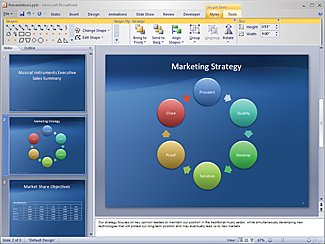 A PowerPoint presentation can be an extremely valuable marketing tool for businesses in this day and age. Here are a few common mistakes that you should try to avoid when creating your presentations…
A PowerPoint presentation can be an extremely valuable marketing tool for businesses in this day and age. Here are a few common mistakes that you should try to avoid when creating your presentations…
1. Excessive Animation
Excessive animation can really distract from a presentation. Keep animation to a minimum. Transitions between slides may be appropriate, but a constantly-moving animated image on a slide can make the text on the slide difficult to read, and can distract the viewer from the message.
2. Content Stuffing
Attempting to include too much content on the slide can be frustrating for audience members, who are trying to read the slide and listen to the presentation at the same time. The PowerPoint slides should be used simply to highlight and emphasize the talking points. Bulleted lists work great for this, rather than blocks of full text that simply duplicate what the speaker is saying.
3. Including Fancy Fonts
Not only are fancy fonts distracting and difficult to read, but many versions of PowerPoint do not embed fonts by default — which means that you may have a font in your presentation that someone else, or another computer, does not have.
4. Speaking “At” The Audience Instead Of “To” Them
It is important that the presenter engage the audience. Simply reading the PowerPoint slides will not result in a good or memorable presentation.
5. Unrelated Design Theme
Do not force your PowerPoint design to fit your topic. Instead, find a design that is flexible and will enhance your presentation. There are literally thousands of PowerPoint templates and backgrounds available, covering nearly any topic. Finding a layout that meets your needs should not be too difficult. For example, check out the PowerPoint backgrounds and layouts found at www.ppt-templates.net.
6. Inconsistency
The design theme should be consistent throughout the presentation. A consistent presentation will flow much smoother and be more cohesive, as opposed to slides with different graphic elements and backgrounds that can cause the audience to focus more on the changing graphics and backgrounds than on the message itself.
7. Excessive Slides
The success of a presentation is not determined by the number of slides in the presentation. More is not always better! Do not use an excessive number of slides in your presentation if they aren’t absolutely necessary.
8. Lack Of Preparation
Practice makes perfect. The best presentations are prepared and rehearsed well in advance of the actual presentation. Make sure you prepare adequately, and practice the presentation multiple times.
9. Not Testing Equipment
It makes sense to do a run-through of your presentation BEFORE the actual presentation. Test the hardware, lens focus, microphones, etc, in advance. This will allow you to catch and resolve any technical issues… without having to do it in front of your audience.
10. Distributing Handouts
If you have handouts or promotional materials, wait until after the presentation is completed to distribute them. Handing them out before or during the presentation can disrupt the flow your presentation, and can result in the audience becoming distracted.
11. Lack Of Confidence
A confident speaker who knows the material will win every time over a speaker who lacks confidence.
12. No Connection
Connect with the audience by engaging them in the presentation. Maintain eye contact with audience members while you are speaking.
13. Failure To Walk The Walk
Dress the part, because first impressions do matter. As they say, you should always “dress for success.” If you dress in a professional manner, your audience will be more inclined to listen to your presentation, and will take you more seriously.
Making a public presentation is never easy for most of us, but avoiding the above issues will help make your presentation much more successful and error-free.
About the Author: Sharon Housley manages marketing for FeedForAll software for creating, editing, publishing RSS feeds and podcasts. In addition Sharon manages marketing for RecordForAll audio recording and editing software.